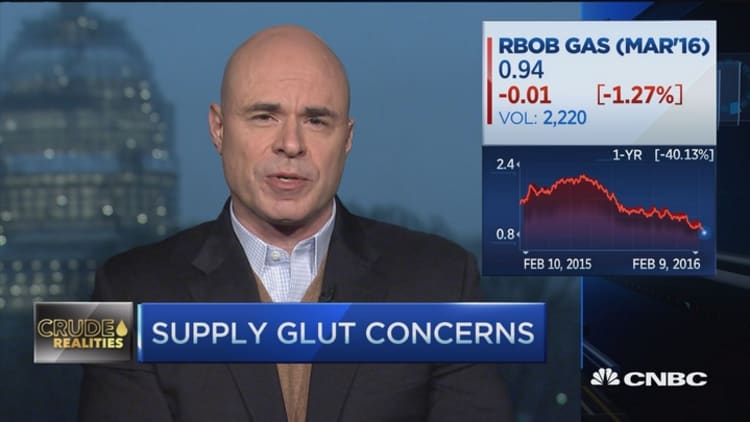
U.S. production slipped from highs. Oil supplies hit record levels. Oil ministers and energy tycoons from Moscow to Riyadh hinted that production cuts — or at least a meeting to discuss them — are on the table.
A perfect storm appeared to be brewing around oil markets at the start of the year, but the winds that looked as if they might at least partially reverse the oil price rout appear to be dying down. Now, a number of experts see 2016 as another waiting game.
The International Energy Agency on Tuesday said it believes demand growth will fall significantly, and the global oil surplus will be larger than the group earlier forecast.
IEA identified five key factors that could trigger a rebound: a coordinated output cut by OPEC and non-OPEC producers, slower OPEC production growth, a boost to demand growth as prices remain low, U.S. dollar devaluation, and significant declines in non-OPEC production.
Now, all of those factors are in doubt, IEA said.
Until there's shock and awe in terms of bankruptcies and super-low prices, there's going to be unrelenting selling pressure in this market.John Kilduffpartner, Again Capital
OPEC on Wednesday echoed the IEA by lowering its own oil demand forecast. It said the market remains oversupplied by 2 million barrels per day. Yet it reported that its members' total production rose by 131,000 barrels to an average 32.3 million per day, citing secondary sources.
Nigeria, Iraq, Saudi Arabia and Iran are responsible for the increases, OPEC said. Only a day before, an executive at Kuwait Petroleum Corp. said the country plans to increase production by 150,000 barrels per day.
Those numbers raise concerns about reports lately that players such as Russia, Saudi Arabia and Iran are serious about meeting to discuss a production cut.
The Saudis, who spearheaded the current OPEC policy, will not agree to production cuts until they're confident that U.S. shale producers will not step up production afterward, John Kilduff, partner at investment advisory firm Again Capital told CNBC.
The Saudis likely won't feel comfortable about the chances of a U.S. output boost until production in the United States falls to 8.5 million barrels per day, Kilduff said. But it could be next year before U.S. output hits that level, he added.
U.S. oil production has fallen from a peak last year of nearly 9.7 million barrels per day to about 9.2 million, according to preliminary weekly EIA data.
"Until there's shock and awe in terms of bankruptcies and super-low prices, there's going to be unrelenting selling pressure in this market," Kilduff said. "We're going to have to wait to see what happens after the nuclear winter clears."
Kilduff said he's more convinced than ever that U.S. crude will eventually dip to $18 a barrel. It traded as low as $27.39 on Wednesday.
To be sure, financial pressures are mounting on U.S. drillers as they cope with such low prices. On Monday, investors ran for the exits on a report — later denied — that No. 2 U.S. natural gas driller Chesapeake Energy had hired advisors to file for bankruptcy. And on Tuesday, shares of Anadarko Petroleum sold off as the company slashed its dividend.
Forty-eight North American oil and gas companies have filed for bankruptcy since 2015, according to law firm Haynes & Boone. The next shakeout could come in April, when banks reassess the value of the assets against which drillers borrow money. Lenders have thus far been accommodating to the energy companies, hoping to avoid pushing energy firms over the edge and winding up owning their assets.
But a survey by Haynes & Boone suggests banks will tighten lending this spring. Lenders expect a 25 percent decrease from 2015 borrowing base levels, while borrowers anticipate a 28 percent cut.
Kevin Book, head of research at advisory firm ClearView Energy Partners, said that only time can bring cuts to production, and at any rate the effect of falling output on prices has likely been pushed back to the fourth quarter of this year.
He called cooperation between OPEC and Russia a myth and said that coordination within the producer group is greatly overstated.
What's more, OPEC has historically timed cuts to coincide with thinning inventories in order to gain market power.
IEA said stockpiles for the wealthy countries in the Organization for Economic Cooperation and Development were 350 million barrels above their average for this time of year, and preliminary data suggest that those stocks have only continued rising. Meanwhile, total U.S. supplies are near historic highs above 500 million barrels.
"That means a longer workout, a bigger overhang, and no reason to get excited about a small [price] pop on a short day," Book told CNBC's "Squawk Box" on Tuesday.
Dallas Federal Reserve President Robert Kaplan last week told a gathering of real estate professionals that it could be mid-2017 until oil markets balance, Reuters reported. He said the amount of oversupply might remain stuck at 300,000 barrels per day by the end of the year, according to the news agency.





